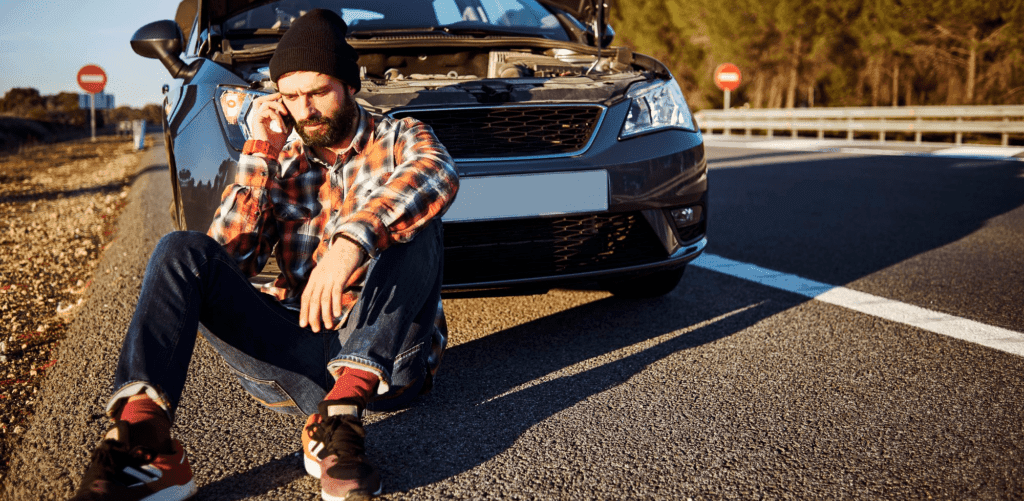
Introduction
Breaking down on the road can be a nerve-wracking experience, especially for new or learner drivers. Knowing what to do if your car breaks down is crucial for ensuring your safety and the safety of other road users.
This guide will walk you through the necessary steps to take, helping you stay calm and handle the situation efficiently.
Importance of Knowing What to Do
Understanding the importance of knowing what to do during a car breakdown is essential. A breakdown can happen anytime, anywhere, and often without warning.
Being prepared can prevent further accidents, reduce stress, and get you back on the road as quickly as possible. This knowledge can also save you from making potentially costly mistakes.
Overview of Steps to Take
When your car breaks down, there are several steps you need to follow to ensure your safety and resolve the issue.
These include:
- Staying calm
- Turning on your hazard lights
- Safely pulling over
- Contacting a breakdown service
Each of these steps is crucial and will be elaborated on in this guide to help you manage a breakdown situation effectively.
I’ve Broken Down – What Should I Do?
Stay Calm and Assess the Situation
The first thing you need to do when your car breaks down is to stay calm and assess the situation.
Panicking will only make things worse and could lead to poor decision-making. Take a few deep breaths and try to think clearly about what needs to be done.

- Check your surroundings: Are you on a busy motorway, a quiet country road, or in the middle of a city? Your location will influence your next steps.
- Look for immediate dangers: Are you in a safe spot, or is your car in the way of traffic? If you’re in a dangerous position, your priority should be to move to safety.
- Identify the problem: If possible, try to understand what caused the breakdown. Is it a flat tyre, engine trouble, or something else? This can help you communicate more effectively with the breakdown service.
Turn on Hazard Lights
Turning on your hazard lights is a critical step when your car breaks down. Hazard lights alert other drivers that your vehicle is stationary and not just slowing down or stopping temporarily. Here’s how and why you should use them:

- Locate the hazard light button: It’s usually marked with a red triangle and is found on the dashboard.
- Turn them on immediately: As soon as you realise there’s a problem, turn on your hazard lights. This action will help other drivers see you from a distance and slow down accordingly.
- Keep them on until help arrives: Your hazard lights should stay on to continuously warn other drivers of your presence.
Safely Pull Over
Once your hazard lights are on, the next step is to safely pull over. This action is crucial to avoid causing an obstruction or potential accidents. Here’s how to do it safely:
- Choose a safe spot: If possible, pull over to a hard shoulder, lay-by, or a safe area away from the main flow of traffic.
- Avoid stopping on bends or narrow roads: Try to find a straight, wide section of the road where other drivers can see you from a distance.
- Use your mirrors: Check your mirrors and blind spots before pulling over to ensure it’s safe to do so.
- Signal your intentions: Use your indicators to let other drivers know you are moving to the side of the road.
Contact Breakdown Service
After you’ve safely pulled over and ensured your hazard lights are on, it’s time to contact a breakdown service. Here’s what you need to do:

- Know your location: Use landmarks, road signs, or a GPS device to pinpoint your exact location. This information is vital for the breakdown service to find you quickly.
- Call the breakdown service: Use your mobile phone or a roadside emergency phone to contact a breakdown service. In the UK, popular services include the AA, RAC, and Green Flag.
- Provide necessary details: When you speak to the breakdown service, be ready to provide your location, vehicle details, and a brief description of the problem.
- Stay with your vehicle: Unless it’s unsafe, stay with your vehicle until the breakdown service arrives. If you need to leave your vehicle, ensure it’s secure and locked.
Following these steps will help you handle a car breakdown efficiently and safely.
By staying calm, turning on your hazard lights, safely pulling over, and contacting a breakdown service, you can manage the situation effectively and minimise the disruption to your journey.
What to Do If You’ve Broken Down on a Motorway
Breaking down on a motorway can be particularly stressful due to the high speed of traffic and the potential dangers involved. Knowing the correct procedures can significantly enhance your safety.

Pull Over to the Hard Shoulder
If your car breaks down on a motorway, your first priority is to pull over to the hard shoulder. Here’s how to do it safely:
- Signal and move over: Use your indicators to signal your intentions and move gradually towards the hard shoulder.
- Stay to the left: Once on the hard shoulder, try to position your car as far to the left as possible to maximise the distance between your vehicle and the motorway traffic.
- Stop safely: Come to a complete stop and apply the handbrake. Turn your wheels to the left to ensure the car does not roll into traffic if it gets hit.
Exit the Vehicle Safely
Once you’ve stopped on the hard shoulder, you need to exit the vehicle safely. Follow these steps:
- Leave through the passenger side: If possible, exit the vehicle through the passenger side to avoid stepping into the path of oncoming traffic.
- Ensure all passengers exit: Make sure everyone in the car exits safely, particularly if there are children or pets.
- Take necessary belongings: Take your phone and any essential belongings with you as you exit.
Stand Behind the Barrier
After exiting the vehicle, it’s crucial to stand behind the barrier for safety:
- Move away from the vehicle: Ensure you and your passengers move away from the car and stand behind the safety barrier.
- Find a safe spot: Position yourselves as far away from the road as possible, ideally on the grass verge behind the barrier.
- Stay together: Keep your group together and ensure everyone is accounted for.
Call for Assistance
Once you are in a safe location, it’s time to call for assistance:

- Use your mobile phone: Contact a breakdown service such as the AA, RAC, or Green Flag. Provide them with your location and details of your situation.
- Use an emergency phone: If you don’t have a mobile phone, use an emergency roadside phone. These are usually located at regular intervals along the motorway and connect directly to a control centre.
- Stay on the line: Remain on the phone and follow the instructions provided by the breakdown service or emergency operator.
Broken Down on a Motorway and Can’t Get to the Hard Shoulder
In some cases, you might not be able to reach the hard shoulder. This situation can be even more dangerous, so it’s essential to know how to protect yourself.
Stay in the Vehicle with Seatbelts On
If you can’t reach the hard shoulder, stay in the vehicle with seatbelts on:
- Remain seated: Stay in your seat and ensure everyone else does the same.
- Keep seatbelts fastened: Make sure everyone keeps their seatbelts on for added protection in case of a collision.
- Stay calm: Encourage everyone to remain calm and avoid any sudden movements.
Turn on Hazard Lights
Activate your hazard lights immediately to alert other drivers:
- Find the hazard light button: It’s usually marked with a red triangle on your dashboard.
- Turn them on: As soon as you realise you can’t move to the hard shoulder, turn on your hazard lights.
- Keep them flashing: Leave the hazard lights on to continuously signal to other road users that your vehicle is stationary.
Call Emergency Services
In this situation, it’s critical to call emergency services as soon as possible:
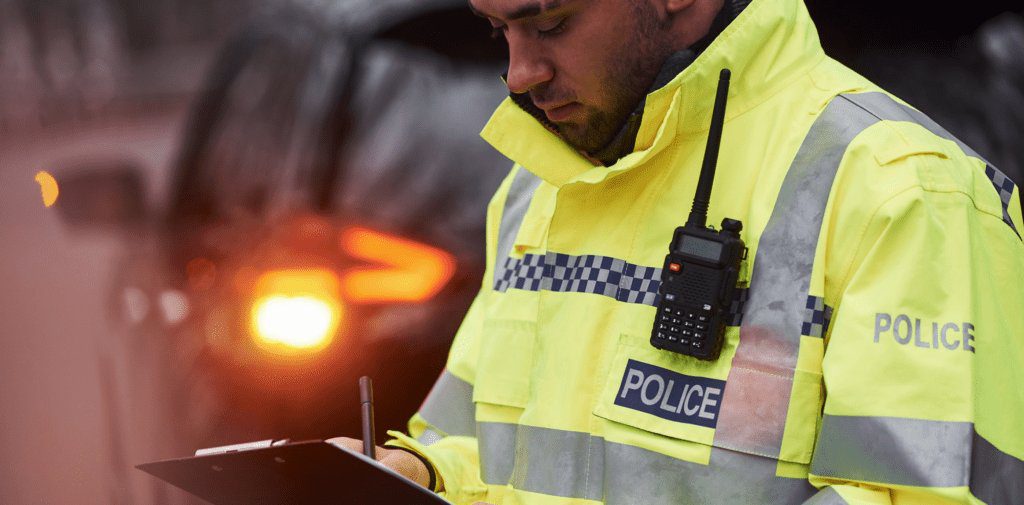
- Dial 999: Use your mobile phone to call the emergency services.
- Provide details: Give them your exact location, the nature of your breakdown, and any other relevant information.
- Follow instructions: Adhere to any advice or instructions given by the emergency operator.
Stay Visible and Alert
While waiting for assistance, it’s important to stay visible and alert:
- Use warning triangles: If you have warning triangles and it’s safe to do so, place them behind your vehicle to alert other drivers.
- Stay awake and aware: Keep an eye on the traffic around you and be ready to react if necessary.
- Signal for help: If you see a police car or other emergency vehicle approaching, use hand signals to draw their attention.
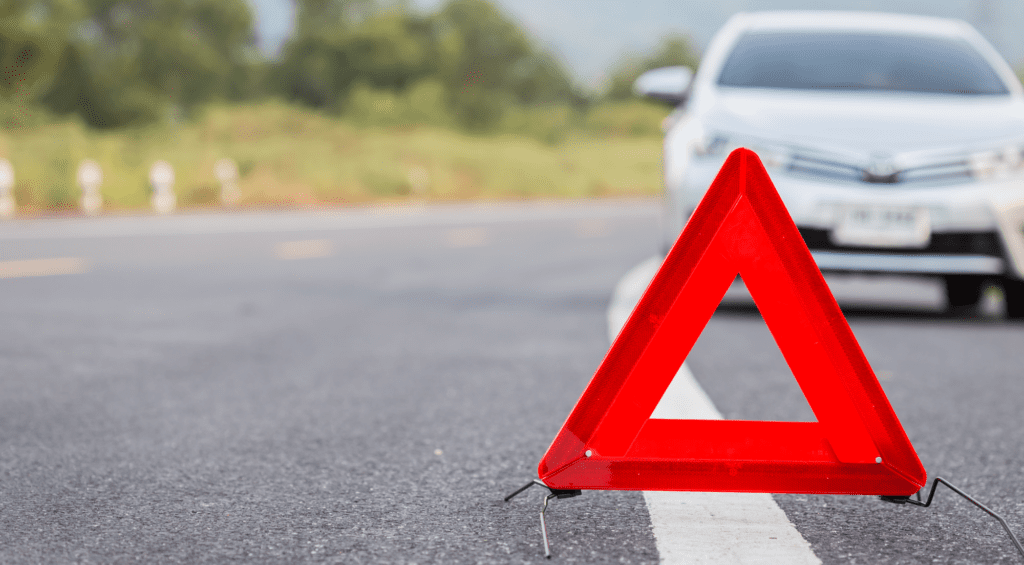
By following these steps, you can significantly improve your safety and the safety of your passengers during a motorway breakdown, even if you cannot reach the hard shoulder.
Broken Down on a Smart Motorway
Smart motorways are designed to improve traffic flow and reduce congestion, but breaking down on one can be particularly challenging due to the lack of a continuous hard shoulder.

It’s crucial to know the specific steps to take in this situation to ensure your safety.
Use the Nearest Emergency Refuge Area (ERA)
When your car breaks down on a smart motorway, your first action should be to use the nearest Emergency Refuge Area (ERA).
These areas are specifically designed for vehicles in distress and are placed at regular intervals along smart motorways. Move your car into the ERA as quickly and safely as possible.

Once inside, turn on your hazard lights to alert other drivers of your presence. Use the SOS phone provided in the ERA to contact the motorway control centre. This will inform them of your situation and allow them to send assistance.

If Unable to Reach ERA, Follow Safety Protocols
If reaching an ERA is not possible, it’s crucial to follow safety protocols to protect yourself and your passengers.
First, turn on your hazard lights to signal to other road users that your vehicle is stationary. If it’s safe to do so, exit the vehicle and move to a safe location behind the barriers.
This reduces the risk of injury from passing traffic. If exiting the vehicle is too dangerous, stay inside with your seatbelts fastened and call for help.
Contact Breakdown Service via SOS Phones
After moving to safety or if you remain in the vehicle, contact a breakdown service via SOS phones. These phones are directly connected to the control centre, which can monitor your situation and dispatch help quickly.
Provide your exact location and a description of your problem to the operator. Follow their instructions carefully to ensure help arrives as swiftly as possible.
Broken Down on a Smart Motorway and Can’t Get to an Emergency Refuge Area
In the event that you break down on a smart motorway and cannot reach an ERA, specific steps must be taken to maximise safety.
Turn on Hazard Lights
Immediately turn on your hazard lights to alert other drivers that your vehicle is stationary. This action helps other motorists see your vehicle from a distance and take necessary precautions.
Stay in the Vehicle with Seatbelts On
If you cannot move to an ERA, stay in the vehicle with seatbelts on. Keeping your seatbelt fastened will provide an additional level of protection in case your vehicle is struck by passing traffic. Encourage all passengers to remain seated and buckled.
Call Emergency Services
As soon as you realise that you cannot reach an ERA, call emergency services. Dial 999 and provide the operator with your precise location, details about your vehicle, and the nature of your breakdown. This information is critical for emergency responders to locate you quickly.
Follow Instructions from Traffic Officers
While waiting for assistance, it is essential to follow instructions from traffic officers. Traffic officers may arrive on the scene to manage traffic and ensure your safety.
They may provide specific directions on what you should do next, such as moving to a safer area or staying in your vehicle. Adhering to their guidance is crucial for maintaining safety until help arrives.
By understanding these steps and following them diligently, you can ensure the safety of yourself and your passengers during a breakdown on a smart motorway, even when you cannot reach an ERA.
Knowing these protocols helps manage the situation effectively and minimises the risk of further incidents.
What to Do If Your Car Breaks Down on a Country Road
Breaking down on a country road can be less stressful than on a busy motorway, but it still requires careful handling to ensure safety.
Knowing the right steps to take can make a significant difference in managing the situation effectively.

Pull Over to a Safe Location
When you realise your car is breaking down on a country road, the first thing to do is pull over to a safe location.
Look for a wide area off the road where you can stop without obstructing traffic or endangering yourself. If possible, aim for a lay-by or a driveway, as these provide more space and safety compared to stopping on the road itself.
Turn on Hazard Lights
After pulling over, turn on your hazard lights to alert other drivers to your stationary vehicle. This is especially important on country roads, where visibility might be limited due to bends, hills, or foliage.
Keeping your hazard lights on ensures that approaching vehicles can see you from a distance and adjust their speed accordingly.
Set Up Reflective Triangles
Once your hazard lights are on, the next step is to set up reflective triangles. These should be placed at least 45 metres behind your vehicle to provide additional warning to oncoming traffic.
Reflective triangles are particularly useful on country roads where the visibility might be compromised due to narrow lanes and lack of street lighting.
Always ensure you place the triangles in a safe manner, avoiding standing in the road where possible.
Contact Breakdown Service
With your car safely pulled over and hazard lights on, it’s time to contact a breakdown service.
Use your mobile phone to call for assistance, providing them with your exact location. Describing nearby landmarks or using GPS coordinates can help the service locate you more quickly.
Stay by your vehicle if it’s safe, or move to a safer location if necessary, and wait for the breakdown service to arrive.
Preparing for a Breakdown
Being prepared for a potential breakdown can save you a lot of stress and hassle. It involves having the right items in your car, maintaining your vehicle regularly, and knowing your breakdown service details.
Essential Items to Keep in Your Car
Keeping essential items in your car can be a lifesaver during a breakdown. These items include:
- A first aid kit
- A high-visibility jacket
- A torch with extra batteries
- Reflective triangles
- A basic toolkit
- A spare tyre with the necessary tools for changing it.
Additionally, having some bottled water, non-perishable snacks, and a blanket can provide comfort if you need to wait for help in adverse weather conditions.
Regular Vehicle Maintenance
One of the best ways to avoid breakdowns is through regular vehicle maintenance. Regularly checking and servicing your car can identify potential issues before they become serious problems.
Ensure your oil, coolant, brake fluid, and tyre pressure are checked frequently. Regular servicing by a professional mechanic can also help keep your car in top condition and reduce the risk of unexpected breakdowns.
Knowing Your Breakdown Service Details
It’s crucial to know your breakdown service details. Keep the contact number of your breakdown service provider readily available, either stored in your phone or written down in your vehicle.
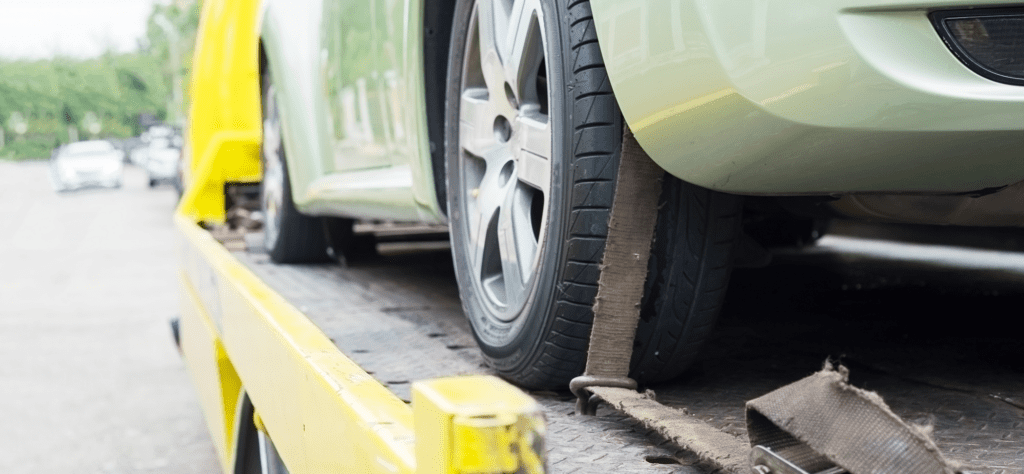
Additionally, knowing your membership or policy number can speed up the process when you call for help.
Familiarise yourself with the terms of your breakdown cover so you understand what services are included and any potential costs you might incur.
By following these guidelines and being well-prepared, you can handle a car breakdown on a country road with confidence and efficiency, ensuring your safety and minimising the inconvenience.
Regular maintenance and preparedness can go a long way in preventing breakdowns and managing them effectively when they occur.
Safety Tips While Waiting for Assistance
While waiting for assistance during a breakdown, it’s essential to prioritise your safety and the safety of your passengers.
Understanding how to stay visible, avoid potential threats, and cope with adverse weather conditions can make a significant difference.
Staying Visible and Safe
Staying visible and safe is paramount when you’re waiting for assistance. Make sure your hazard lights remain on to alert other drivers of your stationary vehicle.
If you have reflective triangles, ensure they are correctly positioned to give oncoming traffic ample warning.
Wearing a high-visibility jacket can also help you stay visible, especially if you need to move around the vehicle or signal for help.
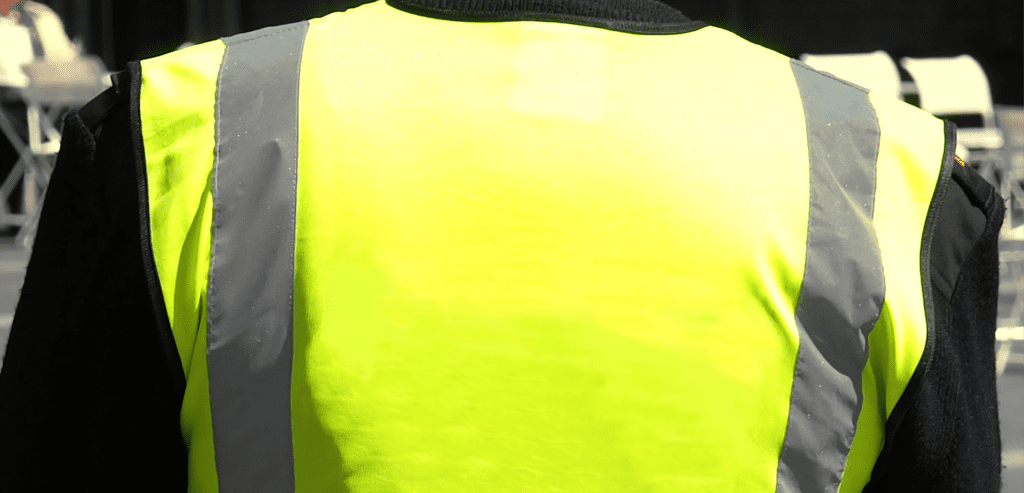
Always stay behind barriers if you’re on a motorway, and avoid standing close to the road where passing vehicles could pose a danger.
Avoiding Strangers
Avoiding strangers is another crucial safety tip. While most people who stop might genuinely want to help, it’s important to remain cautious.
If someone approaches your vehicle, keep your doors locked and only lower your window slightly to communicate.
Politely decline any offers of help and inform them that professional assistance is on the way. If you feel threatened at any point, contact the emergency services immediately for support.
Keeping Warm and Safe in Adverse Weather
Keeping warm and safe in adverse weather is essential, particularly if you’re stranded for an extended period.
In cold weather, use blankets and wear extra layers of clothing to retain body heat. Running your engine for short periods can provide some warmth, but make sure your exhaust pipe isn’t blocked to prevent the build-up of harmful fumes.
In hot weather, try to stay in the shade and keep hydrated. Having a supply of water and non-perishable food in your car can be a lifesaver in these situations.
Common Causes of Car Breakdowns
Understanding the common causes of car breakdowns can help you prevent them and be better prepared to deal with them when they occur.
Flat Tyres
Flat tyres are a frequent cause of breakdowns. They can occur due to punctures, incorrect tyre pressure, or general wear and tear.
Regularly checking your tyres for damage and maintaining the correct pressure can reduce the risk of a flat tyre.
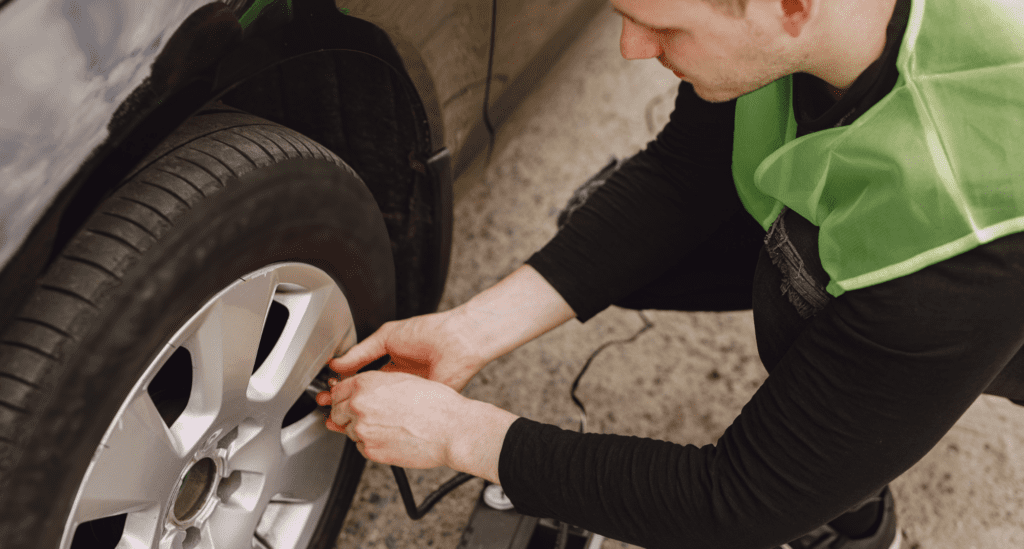
Carrying a spare tyre and knowing how to change it can also be very useful if you encounter this issue.
Battery Issues
Battery issues are another common cause of breakdowns. A flat battery can result from leaving lights or electrical systems on when the engine isn’t running, especially in older vehicles.
Regularly checking your battery’s condition and ensuring it’s properly charged can help prevent this problem.
In cold weather, battery performance can decrease, so it’s essential to be particularly vigilant during winter months.
Engine Problems
Engine problems can range from minor issues like overheating to more severe mechanical failures. Regular servicing and maintenance are key to keeping your engine in good working order.
Ensure you check the oil levels frequently and top up as needed, as running low on oil can cause significant damage to your engine.
Fuel Problems
Fuel problems are often a simple yet surprisingly common cause of breakdowns. Running out of fuel or using the wrong type of fuel can leave you stranded.
Always ensure your fuel gauge is working correctly and make a habit of refuelling before you get too low.
If you accidentally use the wrong fuel, don’t start the engine and contact a breakdown service immediately for assistance.
By being aware of these common causes and taking preventive measures, you can reduce the likelihood of experiencing a breakdown.
Regular maintenance and careful monitoring of your vehicle’s condition are essential practices for any driver.
How to Prevent Car Breakdowns
Preventing car breakdowns involves a proactive approach to vehicle maintenance. By following a few key practices, you can significantly reduce the risk of encountering problems on the road.
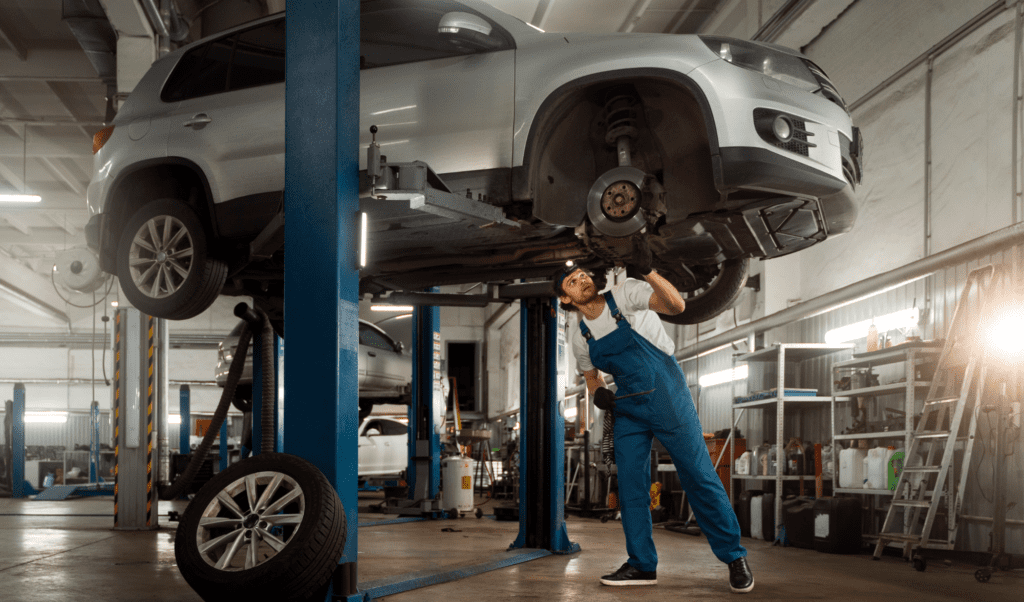
Regular Servicing and Maintenance
Regular servicing and maintenance are fundamental to keeping your car in good working condition. Scheduled services should be adhered to as specified in your vehicle’s manual.
These services typically include:
- Checks and replacements for essential components like the engine oil
- Air filters
- Brake pads, and more
Regular maintenance helps identify potential issues before they become serious problems, ensuring your car runs smoothly and efficiently.
Checking Tyres and Fluids
Regularly checking tyres and fluids is another essential practice to prevent breakdowns. Tyres should be inspected for:
- Proper inflation
- Tread depth
- Any signs of damage or wear
Maintaining the correct tyre pressure not only prevents flats but also improves fuel efficiency and handling.
Additionally, checking and topping up fluids such as:
- Engine oil
- Coolant
- Brake fluid
- Windscreen washer fluid is crucial.
These fluids are vital for the optimal performance of your car’s systems and can prevent overheating, braking issues, and other problems.
Keeping Fuel Levels Adequate
Keeping fuel levels adequate is a simple yet often overlooked aspect of vehicle maintenance. Running low on fuel can lead to unexpected breakdowns, especially in remote areas where fuel stations are scarce.
It’s advisable to refuel when your tank is down to a quarter full. This habit not only prevents running out of fuel but also protects your fuel pump, as running on low fuel levels can cause it to overheat and fail prematurely.
What to Tell the Breakdown Service
When you experience a breakdown and need to call for assistance, providing clear and accurate information to the breakdown service is essential. This ensures that help arrives promptly and prepared for your specific situation.
Your Exact Location
Your exact location is the most critical piece of information you need to convey. Use road signs, landmarks, or GPS coordinates to pinpoint where you are.
If you’re on a motorway or a remote country road, providing precise details helps the service locate you quickly.
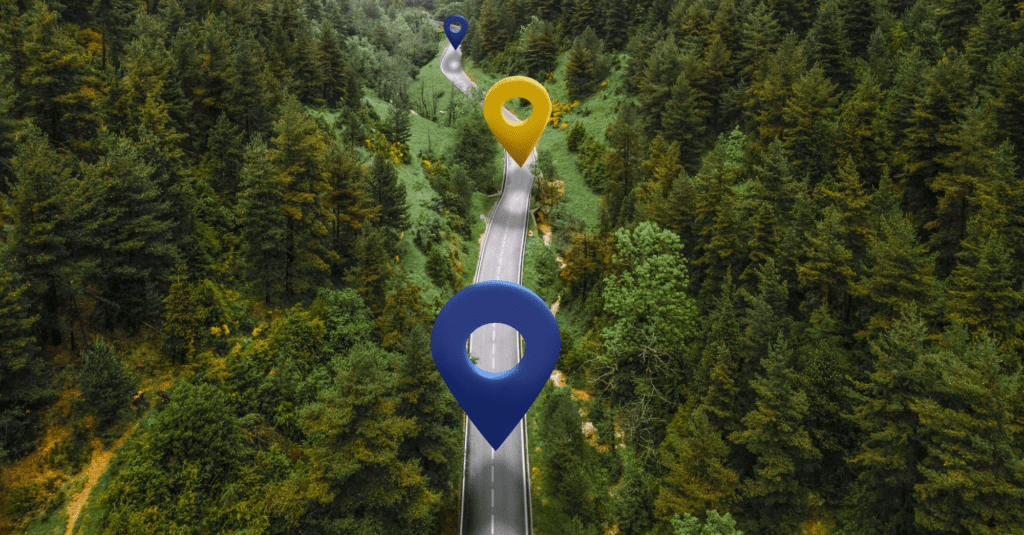
Mentioning nearby exits, mile markers, or identifiable features can be extremely helpful.
Nature of the Breakdown
Describing the nature of the breakdown is crucial for the breakdown service to understand what kind of assistance you need.
Explain whether you have a flat tyre, engine trouble, battery issues, or another problem.
This information allows the service to send the appropriate equipment and personnel to address your specific issue efficiently.
Any Safety Concerns
Communicating any safety concerns is vital to ensure that both you and the responding service are aware of potential hazards.
If your vehicle is in a dangerous position, such as on a busy road or in a location with poor visibility, make sure to highlight these concerns.
Mentioning any immediate threats or unsafe conditions can help the service take necessary precautions when approaching your vehicle.
Vehicle Information
Providing vehicle information is also important for the breakdown service to prepare adequately.
This includes the:
- Make, model, and registration number of your vehicle.
- Additionally, informing them of any modifications or specific details about your car can be beneficial.
For instance, if you drive a hybrid or electric vehicle, the service may need to send a technician with specialised knowledge and tools.
By following these guidelines and ensuring your car is well-maintained, you can prevent many common breakdowns and handle those that do occur more effectively.
Accurate and detailed communication with the breakdown service will ensure a swift and efficient resolution to your predicament.
Frequently asked questions
The first thing you should do is stay calm and turn on your hazard lights.
This alerts other drivers that your vehicle is stationary and helps prevent accidents.
You should pull over to the hard shoulder if possible. Ensure you position your car as far to the left as possible to maximise safety.
If you can’t reach an ERA, stay in your vehicle with your seatbelts on, turn on your hazard lights, and call emergency services immediately.
Follow instructions from traffic officers if they arrive on the scene.
Turn on your hazard lights and set up reflective triangles if it’s safe to do so. Wearing a high-visibility jacket can also help make you more visible.
It depends on the safety of the situation. If it’s safe to exit, stand behind the barrier or at a safe distance from the road.
If it’s not safe to exit, stay in your vehicle with your seatbelt on.
Provide your:
- Exact location
- A description of the breakdown
- Any safety concerns
- Detailed information about your vehicle, such as:
- make, model, and registration number.
Regular servicing and maintenance, checking tyres and fluids, and keeping adequate fuel levels are essential practices to prevent breakdowns.
Politely decline any offers of help and inform them that professional assistance is on the way.
Keep your doors locked and only lower your window slightly to communicate if necessary.
Essential items include:
- A first aid kit
- High-visibility jacket, torch with extra batteries
- Reflective triangles
- Basic toolkit
- Spare tyre
- Bottled water
- Non-perishable snacks
- A blanket
Stay warm by using blankets and wearing extra layers in cold weather.
Run the engine for short periods to generate heat, ensuring the exhaust pipe isn’t blocked. In hot weather, stay in the shade and keep hydrated.



